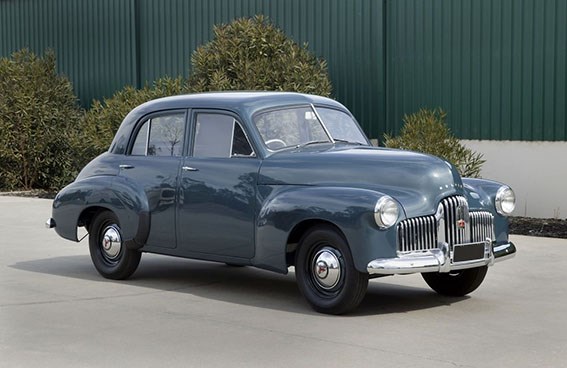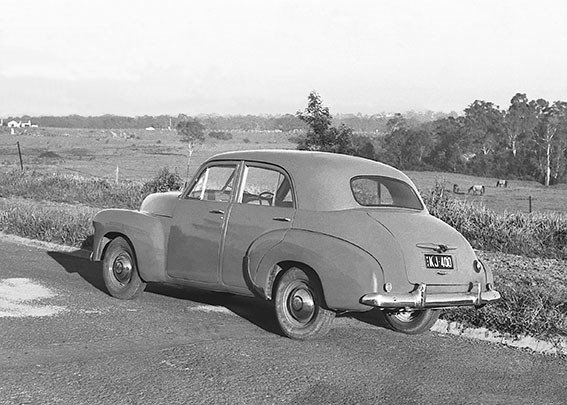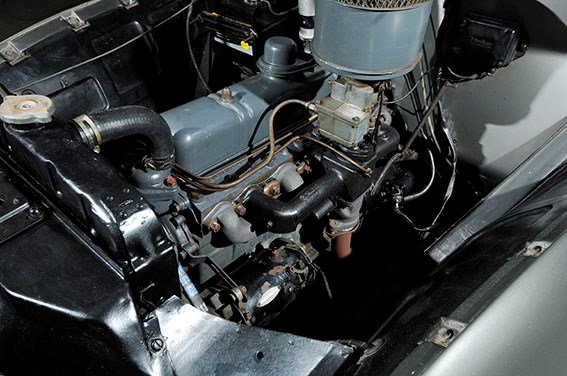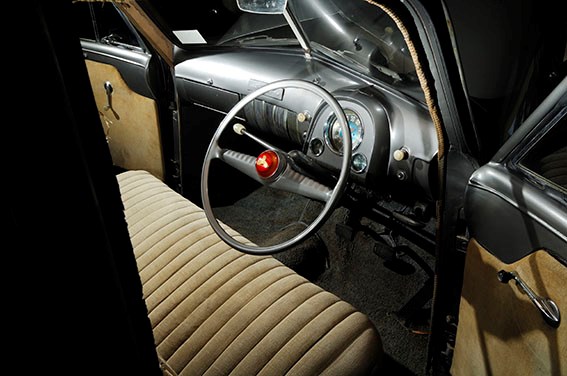Holden FX Review: Classic Metal
 Classic metal: FX Holden
Classic metal: FX Holden

 Classic metal: FX Holden
Classic metal: FX Holden

 Classic metal: FX Holden
Classic metal: FX Holden

 Classic metal: FX Holden
Classic metal: FX Holden


|
|
Classic metal: FX Holden
|

|
|
Classic metal: FX Holden
|

|
|
Classic metal: FX Holden
|

|
|
Classic metal: FX Holden
|
Meet the car that kicked local manufacturing into gear

|
|
Classic metal: FX Holden
|
Holden FX
There have been millions since, but the silver paint you see here highlights the curves of the very first Australian-made Holden. With a mix of US and Aussie parts, this fourth of five 'Holden' prototypes was hand-built by General Motors-Holden's Ltd in 1947 after three US-made prototypes had arrived in Australia in 1946.
This car - and its prototype siblings - was a critical element in the creation of 'Australia's Own' car. Prior to and during WWII (1939-45), Ford Australia and General Motors-Holden were building bodies and plenty of individual components from Australian raw materials, but a wholistic approach to car production didn't exist.
Building a car from scratch would symbolise and promote Australia joining the modern age of mass production. Shiny paint and the promise of freedom for the working man and his family would make Australia's Own car a source of incredible personal and national pride, far beyond the sum of its parts.
FATHER FIGURE
Australia's Own didn't quite turn out the way legend would have it. Speaking on ABC TV's Quantum show just before his passing in 1986, the man regarded as the 'father of the Holden', Laurence Hartnett (who was knighted in 1965), recounted his pitch to US GM heavies after the Australian government's encouragement.
Hartnett, head of GM-H, had been in an enviable position to push the company's role in Australia's Own. He was well-regarded by GM, having worked for the company in several countries, and had been Australia's Director of Ordinance Production during WWII.
"I started by putting to [GM management] the characteristics and resources of Australia," Hartnett said. "Not one of them had ever been to Australia, so many things I said to them was a great surprise to them. They didn't know much about what was being done in this country. They had a tendency to interpret Australia as a big country of open spaces with a man on a horse with a bunch of sheep in the background, and to find we were producing steel, and of a good quality and at a low price, in itself was amazing."
Hartnett met with resistance, especially from GM boss Alfred P Sloan, who regarded the Australian government's involvement with suspicion. Eventually, Hartnett was asked if he wanted the Chevrolet, the Vauxhall or the Opel to be manufactured in Australia.
"I said, 'None of them'," Hartnett recalled. "It would be designed for low volume - designed for the peculiarities of Australia." The GM heavies' response? "Goddamn good horse sense!"
Three prototypes were built and, accompanied by a team of Australian and American engineers, were shipped to Australia in 1946. Work quickly began on two more prototypes, with number four completed in August '47 and registered KJ-400 in Victoria as a Chevrolet (as were the other three US prototypes) on 1 September 1947. Exactly one year later, the name Holden was announced for the new car.
The Holden was launched with great fanfare on 29 November 1948, to a crowd that included Prime Minister Ben Chifley but not Laurence Hartnett, who resigned shortly before. The rest, as they say, is history. Or is it?
THE HISTORIAN
"The story had got twisted and bent out of shape over the years," says Holden hobbyist historian Don Loffler. "And the more I went into it… the more I realised that [some] of what had been [written] about these cars was not correct."
Thanks to his thorough research, Loffler is well regarded as an authority on early-model Holden history.
"My life-long love of the Holden began when I was nine years old and the Holden came out in 1948," he explains. "It was a young boy's 'love at first sight'! My family got one in 1953 - of course, I thought it was the greatest thing ever invented!"
His passionate research began much later in life. "My son had to write a school project and he didn't know what to do," says Loffler. "So I said, 'How about we do something on the first Holden?' That's when we went to look at the microfilms in the State Library [of South Australia] to look at the newspapers of the time."
The school project changed history. What Don discovered exploded a few long-held beliefs about early Holdens and resulted in a highly-detailed history of the prototype and earliest production Holdens. Don's four - soon to be five - books on early Holdens was kick-started by his first, She's a Beauty. Don is justifiably proud and quick to point out he was inspired by the publication of two books: Norm Darwin's The History of Holden Since 1917 (1983) and Shane Birney's Australia's Own (1986).
Loffler's research, including interviews with Holden staffers, and early dealers and mechanics, has revealed plenty of information about the prototype's later life, too. One of these snippets of info is the fact that due to old age and damage, KJ-400 had an extensive rebuild - and possibly had its body tub replaced - during the 1960s. These days the car is dressed in a silver metallic rather than its original shade of Convoy Grey paint.
THE CURATOR
"Really, there are three first Holdens," says Graeme Cocks who, as curator of the Fremantle Motor Museum, looked after this car while it was on display there. "The first American Holden, the first Australian Holden, and the first production Holden.
The interesting thing about the prototypes - being hand-made - is the fact the production panels don't fit. One of the prototypes ended up in a wrecking yard in the 1950s but none of the parts were sold because they didn't fit anything.
"There are other fascinating aspects, too," continues Cocks. "For instance, the radio grille in the centre of the dash - on this car it's made of little pieces of steel, all tacked together. Someone made that as they didn't have the [production line] tooling ready to make it. Stuff like that makes a car like this interesting, especially to someone who knows early Holdens.
"The federal government gave Holden a big loan [via the Commonwealth Bank and the State Bank of South Australia] to start building cars in Australia. If they hadn't done that, the car would never have been made. So, the push to have the car made in Australia really came from the Federal Government."
THE CUSTODIAN
"I've been a car tragic since my father bought me a model car as a six-year-old," explains Peter Briggs. "As a young kid I used to stand on street corners with my mates looking at cars, trying to figure out what brand the cars were, what models they were, what the number plates meant. We spent hours doing that!"
On arrival in Australia in 1948 with his brood, Peter's father, Reginald Oswald Briggs, put his name down for a new Holden. "It was about an 18-month wait for a new one. We were living in Sydney at the time and we decided we wanted to go to Perth - my mother wanted the Mediterranean climate - so we bought a 1939 Buick and crossed Australia."
Successful in business, Peter started collecting cars in the late-1970s. With his collection, he established the York Motor Museum and its subsidiary, the Fremantle Motor Museum.
"When I [became known for] acquiring cars, people would approach me," says Briggs. "They would offer me significant cars, local and international. If I was going to buy an early Holden, I wanted it to be special."
One such offer ended up being that 'special' Holden. "I got a call out of the blue from Melbourne," he recalls. "I listened to the bloke's story and I bought it sight unseen.
"The guy who sold it to me did so thinking it was one of the three American cars. As it turns out, the car wasn't American. It was later identified as the first Australian-made prototype.
"Back then, there weren't people like Don Loffler publishing books," says Briggs. "In 1980, no-one really cared about the prototype Holdens."
Thanks to Graeme, Peter and Don for their assistance with this story.
SPECIFICATIONS
1947 Holden FX prototype
Engine: 2171cc 6cyl, OHV, 12v
Power: 45kW @ 3800rpm
Torque: 135Nm @ 2000rpm
Gearbox: 3-speed manual
Brakes: drums (f/r)
Weight: 1010kg
Price: £733 (when new)
Production: 120,402 ('48-53)
Unique Cars magazine Value Guides
Sell your car for free right here
Get your monthly fix of news, reviews and stories on the greatest cars and minds in the automotive world.
Subscribe

.jpg)










